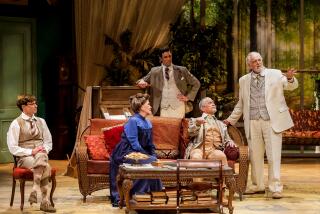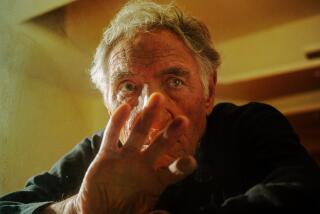Through a Lens, Archly : BERNARD SHAW ON PHOTOGRAPHY <i> edited by Bill Jay and Margaret Moore</i> ; <i> foreword by Michael Holroyd (Gibbs-Smith: $19.95; 146 pp.; 0-87905-338-0) </i>
Letâs get the unpleasantness over with at the beginning. A great dramatist he may have been, a wide-ranging critic, a passionate orator and social activist, and a ferocious humorist.
George Bernard Shaw was not a great photographer, or even, probably, a good one.
But he was prolific. After his death in 1950 at age 94, more than 10,000 photographs were found in his house, crammed haphazardly into cupboards and drawers. Friends observed that he almost always had a camera around his neck, and this is evidenced by both the quantity and the variety of what he left behind: snapshots of loved ones, numerous self-portraits, romantic landscapes, pictures of famous intellectuals and politicians, as well as an occasional dancing bear and a pastoral Irish scene featuring a mother pig in full profile.
Few people know that Shaw was also a first-rate photography critic, the author of a dozen exhibition reviews and critical essays published in important journals and newspapers. He was friendly with some of the best art photographers of the day, and even wrote a specialized technical article for an amateur photography magazine.
Yet his many biographers have largely ignored this lifelong devotion to photography, and Shawâs contributions to the medium have not until now been collected and published in a single volume. Edited by two scholar/artists from Arizona State University, âBernard Shaw on Photographyâ contains all 12 articles as well as an additional photography-related passage from an early novel, 40 images, and a wealth of information about Shaw and his many connections to turn-of-the-century cultural life.
The bookâs authors are careful to point out that as a photographer, Shaw was basically a loving amateur, though itâs clear that he tackled the camera and its aesthetics with the same incessant energy he poured into the rest of his life. Just when his interest in the medium began or where he received his considerable training is uncertain, but by the late 1880s he had become a relentless defender of art photography at a crucial time in its history.
In the years immediately following its invention in 1839, photographyâs sole raison dâetre was thought to be its ability to record visual information with unprecedented clarity and permanence. Seeking respectability, early art photographers imitated the genres and techniques of the more established visual arts, even going so far as to deliberately throw pictures out of focus to create a âromanticâ effect and to paint on negatives to imitate brush work. Their efforts often were met with stiff resistance by the cultural âestablishmentâ and even some photographers, who argued that the mediumâs mechanical/factual nature made it antithetical to art.
Shaw entered this battle with characteristic vigor and venom, promoting the artistic potential of photography so energetically and attacking its enemies so mercilessly that one sometimes cringes at his near-fanatical devotion. âThe old game is up,â he said in an exhibition review printed in The Amateur Photographer in 1901. âThe camera has hopelessly beaten the pencil and paintbrush as an instrument of artistic representation.â
In the same article, he compared two contemporary photographic portraits with the âbest workâ of Holbein, Rembrandt and Velasquez, implied that the latter are guilty of âmonotonous inaccuracy and infirmityâ and suggested that if viewers canât see the difference they are no better than âpicture fanciers.â He constantly urged photographers to remain true to the inherent characteristics of the camera and the photo-chemical process (i.e. sharp focus and clear, unaltered tonalities in their prints), and not give in to the pressure to mimic painting. âAs to the painters and their fanciers,â he proclaimed, âI snort defiance at them; their day of the daubs is over.â
The word moderation was not in Shawâs vocabulary. But he believed above all else in criticism as a process, a dialogue, and such extreme positions must be seen in light of his conviction that the truth can be unearthed only through a kind of Hegelian dialectic: â . . . The way to get at the merits of a case is not to listen to the fool who imagines himself impartial, but to get it argued with reckless bias for and against. To understand a saint, you must hear the devilâs advocate; and the same is true of the artist.â
One quickly becomes endeared to his pugnacious, street-fighterâs style, laced as it is with some of the most potent witticisms and wisecracks ever to flow from pen to paper. Responding to the French photographer Demachy (one of the imitators of painting whom Shaw despised), who had stated unequivocally that purely factual, unmanipulated photography was âantiartistic,â Shaw said that âa photographer imitating the work of a draughtsman is like a man imitating the noises of a barnyard: He may do it very cleverly, but it is an unpardonable condescension all the same.â (The term draughtsman is here used to represent artists who create images by hand, not mechanically.)
While their immersion in the issues of the day makes some of these essays now seem dated, there is still much in them of value to any student of the arts. Shaw had a âcommon-senseâ approach to aesthetics thatâs refreshing, especially given the academic complexities of much of todayâs art criticism. He never lost sight of the essential simplicity of art, its ability to tap into lifeâs fundamental experiences and ideas, to touch people where they live. When all is said and done, he argued, âthe communication of feeling is the true diagnostic of fine art.â
He belittled the tendency among artists and critics to become obsessed with technical and stylistic concerns instead of focusing on the intrinsic content of the image. âThe truth is that neither a photograph nor a painting is necessarily âartisticâ; nor does anybody who knows the ABCs of criticism suppose that Fine Art refers to the processes by which works of Fine Art are produced, instead of to certain qualities of the product.â The qualities he admired are such traditional virtues as honesty, beauty, inventiveness, emotional vitality and old-fashioned craftsmanship. The goal of the photographer was not merely to impart information or âsupply pretty views and striking sunsets,â but instead to âdrive at the poetic,â to produce an image that âplunges you into a mood.â
Ultimately the most useful thing about âBernard Shaw on Photography,â though, is not its polemics, but the glimpse it provides into the life of a truly extraordinary man. Shaw was no saint, as he would have been the first to admit: He could be determined to the point of obstinacy and opinionated verging on sheer orneriness, with an Everest-sized ego to boot. But underneath his diatribes lie a passionate, energetic heart and a boyish enthusiasm for living. He loved to be in the middle of things, âduking it outâ with the heavyweights, yet he still found time to vigorously champion the cause of the poor and downtrodden. Fiercely honest and deeply moral, he was full of anger at the worldâs vulgarities and stupidities. But he never allowed his anger to become bitter, or cynical: You always feel a âYesâ beneath that âNo!â
What artists must strive to hand on to succeeding generations, he said, is âthe most vital part of ourselves.â Thereâs plenty of evidence in this book that Shaw more than lived up to his own standard.
More to Read
Sign up for our Book Club newsletter
Get the latest news, events and more from the Los Angeles Times Book Club, and help us get L.A. reading and talking.
You may occasionally receive promotional content from the Los Angeles Times.







